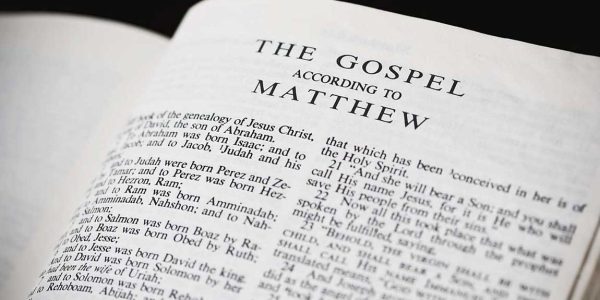The Gospel of the King: Matthew’s Testimony of Christ
The Gospel of Matthew presents Jesus Christ as the long-awaited Messiah and King, fulfilling Old Testament prophecies. This book provides a detailed account of His birth, ministry, teachings, crucifixion, and resurrection. Matthew emphasizes Jesus as the fulfillment of the Law and the establishment of His Kingdom.
Matthew’s Testimony of Christ
The Gospel of Matthew – A Testament of the Messiah
The Gospel of Matthew serves as a bridge between the Old and New Testaments, presenting Jesus as the fulfillment of all Messianic prophecies. Written primarily for a Jewish audience, it repeatedly references the Law, prophets, and promises made to Israel.
✔ Jesus the prophesied Messiah and rightful King.
✔ Emphasizes the Kingdom of Heaven and Jesus’ authority.
✔ Contains the most structured teachings of Christ, including the Sermon on the Mount.
✔ Highlights Jesus’ fulfillment of Old Testament prophecies.
📖 Key Verse: “Think not that I am come to destroy the law, or the prophets: I am not come to destroy, but to fulfil.” – Matthew 5:17
🔎 Matthew’s Gospel is written to demonstrate how Christ fulfills every promise God made to Israel.
Authorship & Structure
📜 Author: Traditionally attributed to Matthew (Levi), a former tax collector and one of the twelve apostles of Jesus. His background gives him a unique perspective on the teachings and works of Christ.
📜 Eyewitness Testimony: As an apostle, Matthew personally witnessed the ministry of Jesus, making his Gospel an authoritative and firsthand account.
📜 Jewish Emphasis: The Gospel of Matthew was written primarily for a Jewish audience, highlighting Jesus as the fulfillment of Old Testament prophecy and the rightful King of Israel.
Structure of Matthew
📖 Chapters 1-4 – The King’s Arrival – Genealogy, birth, baptism, and preparation for ministry.
📖 Chapters 5-7 – The Kingdom Manifesto – The Sermon on the Mount, teaching righteousness and the Kingdom of Heaven.
📖 Chapters 8-10 – Miracles & The Call to Discipleship – Jesus demonstrates His power and sends out His disciples.
📖 Chapters 11-13 – Parables of the Kingdom – Illustrating spiritual truths about God’s rule.
📖 Chapters 14-20 – The Road to Jerusalem – Increasing opposition and preparation for the cross.
📖 Chapters 21-27 – The Passion of Christ – His final days, crucifixion, and sacrifice for sin.
📖 Chapter 28 – The Resurrection & Great Commission – Jesus’ triumph over death and command to spread the Gospel.
🔎 Matthew organizes his Gospel in a structured manner, presenting five major teaching sections (similar to the five books of Moses) to emphasize Jesus as the ultimate Teacher and Lawgiver.
Theological Significance
🔹 Jesus as the Messiah – The fulfillment of all Messianic prophecies, proving that Jesus is the promised King foretold in the Old Testament. Matthew frequently references Scripture to show how Jesus’ life and ministry align with prophecies from Isaiah, Micah, and other prophets.
🔹 The Kingdom of Heaven – A concept unique to Matthew, emphasizing the spiritual reign of Christ both in the present and in the future. Jesus’ parables frequently illustrate what the Kingdom is like and who will enter it.
🔹 Jesus’ Authority – Over the Law, nature, sickness, demons, and even death. Matthew portrays Jesus not only as a teacher but as the divine Son of God with ultimate authority over all things.
🔹 The New Covenant – The transition from the Old Testament law to grace through Jesus Christ. Matthew highlights Jesus as the fulfillment of the Law, not its abolisher, teaching that righteousness comes through faith rather than legalistic adherence.
🔹 The Great Commission – Jesus’ final command to spread the Gospel to all nations, making disciples and baptizing them. This theme underscores the global mission of Christianity and the responsibility of believers to share the Good News.
🔹 Opposition to Christ – From the beginning of His ministry, Jesus faced rejection from religious leaders, persecution, and betrayal. Matthew highlights how this opposition ultimately led to His crucifixion, yet also fulfilled God’s redemptive plan.
🔎 These themes shape Matthew’s Gospel, presenting Jesus as the fulfillment of all that was promised and calling believers to faith, obedience, and discipleship.
Key Old Testament Prophecies Fulfilled in Matthew
🔮 Born of a virgin (Isaiah 7:14 → Matthew 1:23)
🔮 Born in Bethlehem (Micah 5:2 → Matthew 2:1-6)
🔮 Called out of Egypt (Hosea 11:1 → Matthew 2:15)
🔮 Betrayed for 30 pieces of silver (Zechariah 11:12-13 → Matthew 26:15)
🔮 Crucified with transgressors (Isaiah 53:12 → Matthew 27:38)
The Five Major Discourses of Jesus in Matthew
📖 Sermon on the Mount (Chapters 5-7) – Kingdom principles.
📖 Missionary Discourse (Chapter 10) – Sending out the disciples.
📖 Parables of the Kingdom (Chapter 13) – Hidden truths revealed.
📖 Church Discourse (Chapter 18) – How believers should live.
📖 Olivet Discourse (Chapters 24-25) – End-time prophecy.
Literary Features & Writing Style of Matthew
📜 Highly Structured – Matthew follows a deliberate teaching format.
📜 Frequent Use of Old Testament Quotations – To connect Jesus to Jewish history.
📜 Chiastic Structure – Some passages are arranged in a mirrored (A-B-B-A) pattern, common in Hebrew literature.
Matthew’s Unique Perspective Compared to Other Gospels
📖 Matthew – Jesus as the King (Jewish Messiah)
📖 Mark – Jesus as the Servant (Action-focused, Roman audience)
📖 Luke – Jesus as the Son of Man (Humanity & compassion, Greek audience)
📖 John – Jesus as the Son of God (Divinity & eternal nature)
The Role of the Kingdom in Matthew
👑 What is the Kingdom of Heaven? – A central theme in Matthew.
👑 How does it differ from the Kingdom of God? – Examining biblical distinctions.
👑 Parables & Teachings About the Kingdom – Jesus’ lessons on Kingdom living.
🔎 Matthew mentions the “Kingdom of Heaven” 32 times—more than any other Gospel!

Date Written
Approximately 50-60 AD
Written By
The Apostle Matthew (Levi)
Language
Originally written in Greek (with strong Hebraic influence)
Chapters
28
